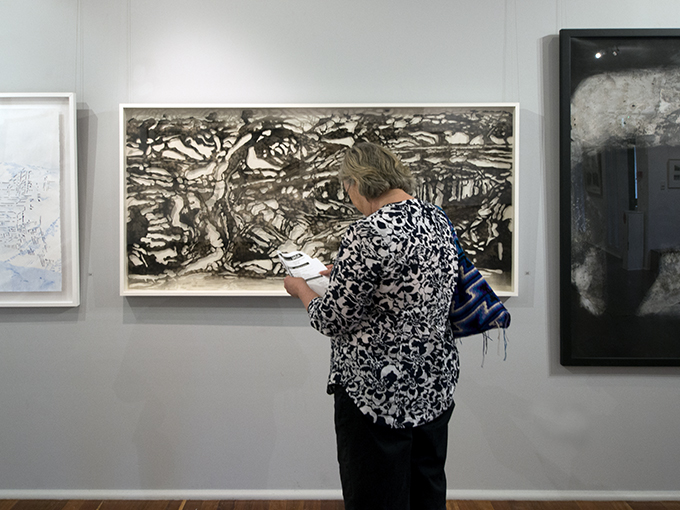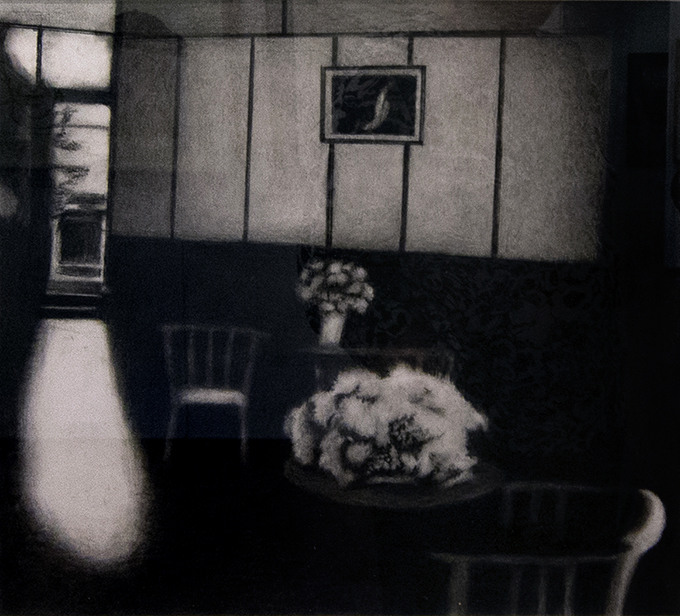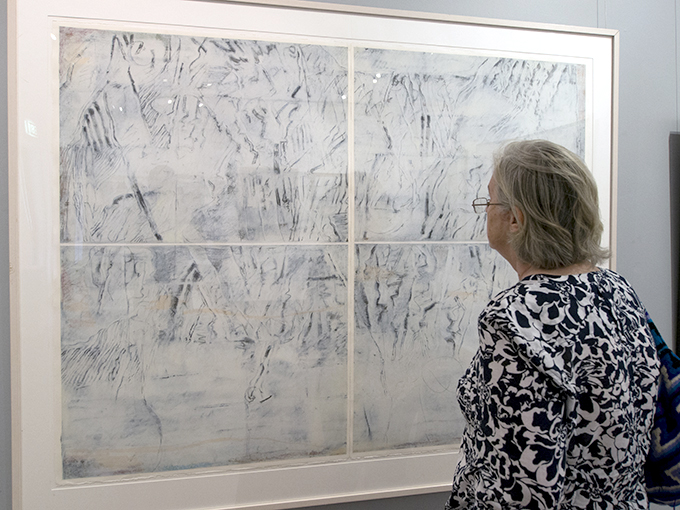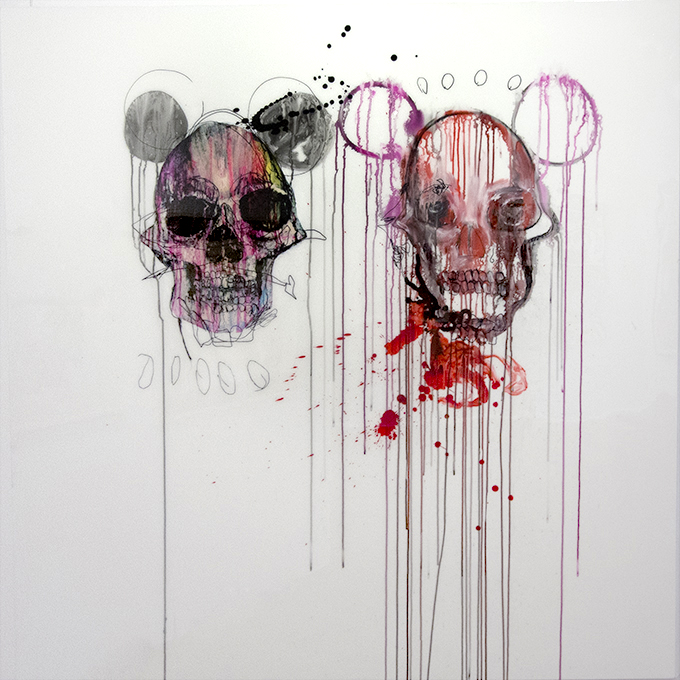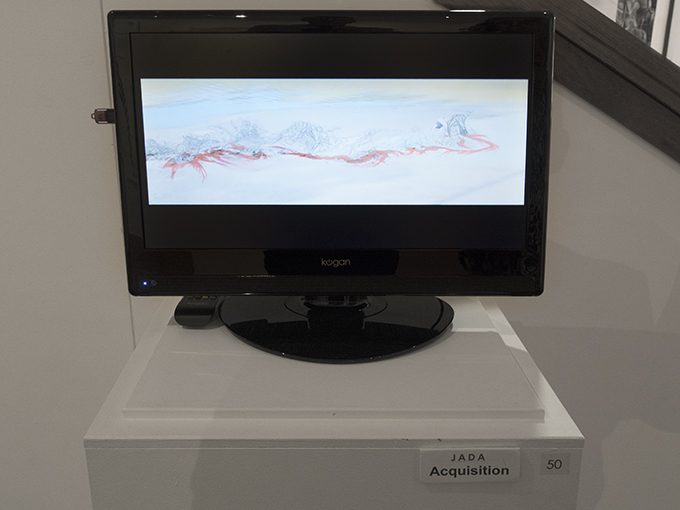Posts Tagged ‘Todd Fuller’
JADA 2020: DRAWING on the PHYSICAL & VIRTUAL Exhibition Space
.
The Pandemic and its significant social disruption has reduced the ability for visitors to enter the physical gallery. However the gallery has reached out through Internet mediated platforms to present online formatted exhibitions to not only to those in lockdown just down the street but also to those geographically distanced from the gallery.
This take-up of online exhibitions has been significant that now it seems that every gallery, as well as entrepreneurial artist, have a virtual gallery. Specialist online providers include Matterport, Ortelia Curator and Exhibbit.
.
Some of these online programs can not only give the gallery a record of virtual attendances and where those visitors came from through their ‘hits’ stats, they may even be able to track the way visitors navigate through the online exhibition space. Bravo to the galleries who have stepped up to provide art interested people a 21st century solution to the COVID-19 challenge to provide a connection with commercial or institutional gallery spaces.
.
.
.
At the end of November 2020 after the relaxation of the Pandemic travel restrictions on the Queensland/New South Wales border we visited the Grafton Regional Gallery and the showing of the 2020 Biennial Jacaranda Acquisitive Drawing Award (JADA).
Earlier in lockdown we visited the 2020 JADA quite a few times via their excellent online gallery. On these virtual visits we were presented with an online experience of being ‘in’ the space with enhancements that enabled us to zoom into full size images of the work and through a ‘click’ button, the ability to read the title of the work, artist’s name and other artwork details. While we were online visiting it was interesting to consider that others from all over the country, or even the world, could be simultaneously in the same virtual gallery space.
.
.
SOME OF THE 2020 JADA FACTS
The JADA exhibition presents a snapshot of the contemporary practice of the drawing artform. The 2020 awards presented 56 works from a record total entry of 659. Pre-selection was carried out by Peter Wood (CEO, Arts Northern Rivers), Brett Adlington (Director, Lismore Regional Gallery, Michael Zavros (artist and 2002 JADA winner), and Heather Brown (President, Friends of Grafton Gallery). The judge of the final Award was Peter McKay, curatorial manager Australian Art at the Queensland Art Gallery — Gallery of Modern Art. A catalogue essay was written by Andrew Frost.
.
Teo Treloar’s work titled This is Impermanence (2019) was announced as the winner and Sarah Tomasetti’s work titled Kailash North Face IV (2019) and, Noel McKenna’s work titled Hamlet (2020) were recommended for purchase for the JADA Collection.
.
.
DRAWING ON THE EXPERIENCE OF THE ARTWORKS
The JADA exhibition reveals a myriad of techniques, media and surfaces. The view of the artwork in the physical space of the gallery is a sensory experience that provides an opportunity to encounter the actual art object and the potential for much closer viewing that can reveal so much more about the work.
For that reason my physical experience in viewing the actual work gave me a deeper experience of the media used and the way it contributed to the artist’s communiqué. Now this may sound as if I’m proposing that the physical beats the virtual but that is not my point. The online space is critical to the broad distribution of the artworks in any exhibition. In many ways the viewing of a pixel presented view of an artwork is not dissimilar to how we experience art in the printed form in a magazine or book.
The online exhibition can convey extended information about the art and the exhibition through downloadable catalogues that cover artist’s statements, the judge’s comments and an essay. What I’m highlighting is that the online exhibition plays an important role in connecting viewers with art that is inaccessible for whatever reason. Seeing the physical object in the gallery is an elevated experience. So it is important to note that JADA is a travelling exhibition and that the ability to physically view the works will be afforded thousands of visitors during its 2 year showing.
It is important to applaud the Grafton Regional Gallery for their initiative in organising, hosting the physical show, coordinating the online exhibition and the touring component. For without JADA’s significant biennial review of the discipline in Australia the drawing community of practice could be fragmented and isolated.
My discussions in this Blog post has been in response to seeing the drawing artworks in the gallery space and connect personally with the detail of the mark and its surface. So to share the richness of the close-up physical experience I approached the Gallery to provide me with access to the catalogue and the information it contains. I have now linked this information with close-up images of selected works from photographs* made while I viewed the exhibition. Through this Blog post I’m attempting to extend the virtual viewer’s experience – it may represent a future enhancement to the online gallery.
Enjoy …
Doug Spowart
*Note some of the photographs contain minor reflections of lighting and other frames from the gallery space.
.
.
View our Blog posts on previous JADA 2018 and JADA 2014
.
Download a copy of the JADA 2020 Catalogue 2020 JADA Catalogue
VIEWING THE JADA 2020 IN DETAIL
“CLICK” Image to enlarge
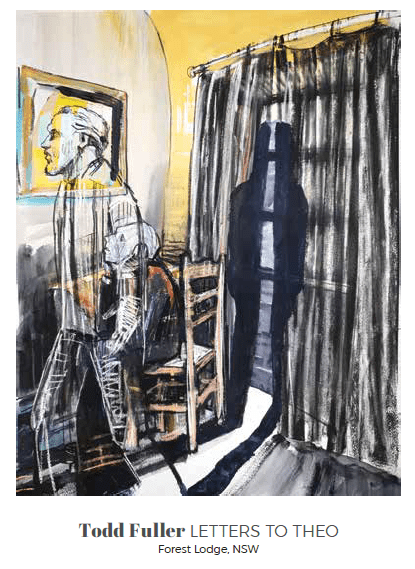
MEDIUM: digital video: chalk, charcoal and acrylic animation on paper, 5:58 minutes (Detail of digital presentation)
VISIT THE ONLINE GALLERY HERE
.
.
.
Thank you to Niomi Sands, Director of the Grafton Regional Gallery and the Gallery team for their support in preparing this Blog post.
In accessing this post please respect the copyrights in the works displayed.
.
.
.
.
THE HIDDEN ART OF DRAWING – REVEALED: JADA 2018
.
Artists fill notebooks with drawings using a range of mark-making methods from burnt sticks (charcoal), lead and coloured pencils to ink pens and colour washes. These can be renderings that replicate the subject in ways that a camera might. They can be of details and juxtapositions of elements. Or they can be quick-made glimpses full of emotion and movement that come not so much from the subject itself but rather from the artist’s response to the inspiration created by what they witness.
Later in the artmaking process the artist retrieves these references and in the studio space with the grander media of canvas, metal or expanses of paper the drawing’s trace is carefully made and through the application of pigments applied by brush and palette knife or engraved, etched, inked and pressed. Here a ‘real’ artwork is made. Yet, underneath the final artwork the reference drawing resides – hidden.
The secret hidden ‘art’ of the artist’s drawing has for 30 years been the focus of the biennial Jacaranda Acquisitive Drawing Award (JADA) at the Grafton Regional Gallery (GRG). In this award the drawing is revered not as an aide-mémoire for the artist’s later work but rather as the product of a deliberate creative and expressive artmaking activity.
The gallery has as it’s rationale for JADA and the GRG Drawing Collection the following statements:
The award seeks to encourage and promote innovation and excellence and plays a vital role in fostering Australian drawing practice.
The … collection exemplifies the developments and changing parameters of contemporary drawing since 1988. The collection explores the way that drawing resonates as a contemporary medium, demonstrating the relevance and strength of drawing. Works in the collection offer a varied and extensive overview of drawing ranging from highly resolved articulate works to spontaneous expressive works that are mostly retained on the conventional support of paper.
… the collection has attractively developed through the tastes, opinions and approaches of the various judges into a collection that is compelling, thought provoking, innovative, exuberant, and diverse.
For those interested in artists in their practice of drawing a visit to the GRG will reveal all. In 2018 fifty-five artworks were selected from 498 entries by a pre-selection panel of suitably qualified persons. The selection of the major JADA award as well as acquisitions for the gallery’s drawing collection were adjudicated by Anne Ryan, Curator of Drawing, Prints and Watercolours from the Art Gallery of New South Wales.
What is surprising in the JADA selection is the way in which the techniques and media of drawing the can lead to such a diverse and stimulating variety of artworks. There are works that:
- Emulate photographs in their fine detail and tonal rendition
- Are exquisite in the draughtsmanship expressed
- Show the artist’s use of the drawing to ‘find the edge’ and give shape and form to the subject
- The emergent use of computer software, digital output, and digital media animation screen presented time-based artworks
- Express the textural nature of the drawing media on the receiving surface
- The passing of time in a stilled framed work
- Explore caricatures
- Play with simple gestural lines and equally simple ideas
The winner of the $30k 2018 JADA award was Todd Fuller, a Sydney based artist with his work titled Ode to Clarence as described in the Gallery’s website as: a hand drawn and painted animation, created during a residency at Grafton Regional Art Gallery.
The work deals with the current issues in Grafton associated with the building of a new bridge connecting the city with the highway. Through a digitally presented narrative relating to the disruption to the community caused by the terraforming, street changes and house demolitions caused by the bridge building. The work is created as a continuous drawing in parts.
Some may question how this work is classified as a ‘drawing’ as we usually encounter a drawing as a static artwork in a notebook, on paper or in a frame. As such time-based digital media presentations and other such works present a challenge to the traditional paradigm. These digital media ‘drawings’ may be documentation of drawing projects or of performances commenting on the concept of drawing. As we know there is a significant history of animated drawings presented as moving picture films. It should also be acknowledged that documentation by video might also make visible a drawing work in transformation. Though it might be asked how do these works ‘fit’ with the term ‘drawing’? And when does a drawing cease being a ‘drawing’ and become a work in the discipline of animation or digital media?
Interestingly Fuller’s drawing work uses a technique similar to that used by the artist Blu in his famous street graffiti video documentary MUTO. Blu describes his work as: …a seven minute animated mural.
Thoughts such as these will no doubt occupy the minds of many visitors to the JADA exhibition as it travels around the eastern seaboard over the next two years. Whatever the outcome for such thoughts ultimately JADA has provided an important biennial review and space for critical commentary and reflection on the discipline and has stimulated this enquiry. The award also reveals and makes visible the work of artists, it shares their stories and ideas through the discipline of drawing – perhaps the oldest of all human creative endeavours.
Dr Doug Spowart
With thanks to Dr Cooper for editorial support
FOOTNOTE:
Other works acquired for the Grafton Regional Gallery Collection with their $10k allocation are:
- David Fairbairn Portrait of T.J.K No 1,
- Kedal Gear Haze,
- Nicci Haynes Drawing Dancing (an animation),
- Noel McKenna Silent Assassin and
- Claire Primrose Assembled Landscape 3.
An illustrated catalogue of the JADA entries can be downloaded here: 2018_JADA_Finalists_Catalogue
Apart from the Gallery exhibition in late 2018 the JADA will tour regional galleries over the next two years to the following venues; Manning Regional Gallery, Hervey Bay Regional Gallery, University of the Sunshine Coast Gallery, Griffith Regional Art Gallery, Latrobe Regional Gallery and the Tamworth Regional Gallery.
.
.
.
.
Text ©2018 Doug Spowart Photographs of gallery ©2018 Doug Spowart. Copyright of artworks is retained by the artist
Many artworks have been photographed to show the nature of the framing and matting of the work.
.
















































